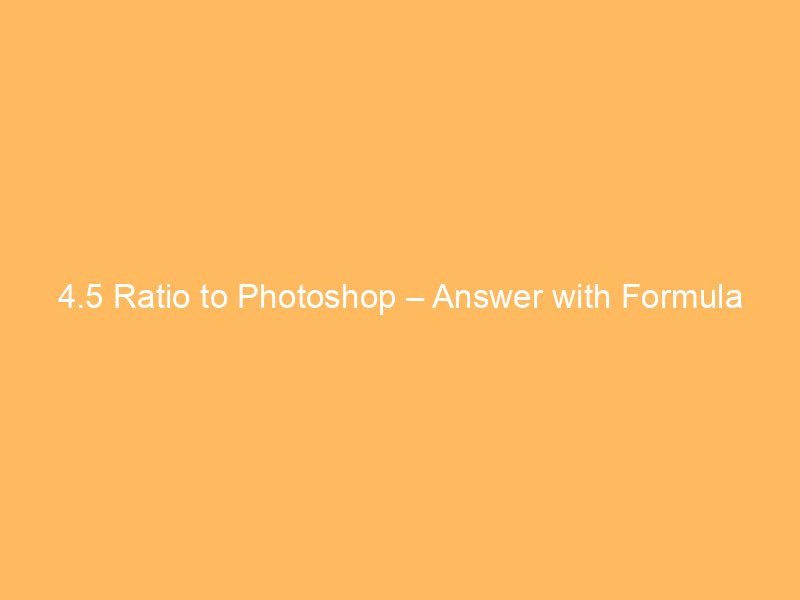The conversion of a 4.5 ratio to Photoshop value results in approximately 0.2222. This means when you input a ratio of 4.5, Photoshop interprets it as a decimal value near 0.2222.
This happens because Photoshop’s ratio unit works as the inverse of the input ratio, converting the number into a fraction that Photoshop can apply for scaling or resizing. The process is about flipping the relationship between the numbers, to fit Photoshop’s expected format for ratios.
Conversion Tool
Result in photoshop:
Conversion Formula
The formula to convert a ratio value to Photoshop is:
Photoshop Value = 1 ÷ Ratio
This formula works because Photoshop expects the ratio as a decimal representing the fraction of the whole. If the ratio is greater than 1, Photoshop’s value becomes the inverse, a decimal less than 1. For example, if you have a ratio of 4.5, dividing 1 by 4.5 gives approximately 0.2222.
Step-by-step calculation:
- Start with ratio = 4.5
- Calculate 1 ÷ 4.5 = 0.222222…
- Result rounded to 4 decimals is 0.2222
Conversion Example
- Ratio: 2.0
- Divide 1 by 2.0
- 1 ÷ 2.0 = 0.5
- Photoshop value is 0.5
- Ratio: 0.25
- Divide 1 by 0.25
- 1 ÷ 0.25 = 4
- Photoshop value is 4.0000
- Ratio: 10
- Divide 1 by 10
- 1 ÷ 10 = 0.1
- Photoshop value is 0.1000
- Ratio: 0.5
- Divide 1 by 0.5
- 1 ÷ 0.5 = 2
- Photoshop value is 2.0000
Conversion Chart
The table below shows values from -20.5 to 29.5 converted into Photoshop values, by dividing 1 by each number. Negative and zero values may produce unusual or undefined results, so caution is advised when using these.
| Ratio | Photoshop Value |
|---|---|
| -20.5 | -0.0488 |
| -19.5 | -0.0513 |
| -18.5 | -0.0541 |
| -17.5 | -0.0571 |
| -16.5 | -0.0606 |
| -15.5 | -0.0645 |
| -14.5 | -0.0690 |
| -13.5 | -0.0741 |
| -12.5 | -0.0800 |
| -11.5 | -0.0870 |
| -10.5 | -0.0952 |
| -9.5 | -0.1053 |
| -8.5 | -0.1176 |
| -7.5 | -0.1333 |
| -6.5 | -0.1538 |
| -5.5 | -0.1818 |
| -4.5 | -0.2222 |
| -3.5 | -0.2857 |
| -2.5 | -0.4000 |
| -1.5 | -0.6667 |
| -0.5 | -2.0000 |
| 0.5 | 2.0000 |
| 1.5 | 0.6667 |
| 2.5 | 0.4000 |
| 3.5 | 0.2857 |
| 4.5 | 0.2222 |
| 5.5 | 0.1818 |
| 6.5 | 0.1538 |
| 7.5 | 0.1333 |
| 8.5 | 0.1176 |
| 9.5 | 0.1053 |
| 10.5 | 0.0952 |
| 11.5 | 0.0870 |
| 12.5 | 0.0800 |
| 13.5 | 0.0741 |
| 14.5 | 0.0690 |
| 15.5 | 0.0645 |
| 16.5 | 0.0606 |
| 17.5 | 0.0571 |
| 18.5 | 0.0541 |
| 19.5 | 0.0513 |
| 20.5 | 0.0488 |
| 21.5 | 0.0465 |
| 22.5 | 0.0444 |
| 23.5 | 0.0426 |
| 24.5 | 0.0408 |
| 25.5 | 0.0392 |
| 26.5 | 0.0377 |
| 27.5 | 0.0364 |
| 28.5 | 0.0351 |
| 29.5 | 0.0339 |
Related Conversion Questions
- How do I convert a 4.5 ratio to Photoshop scale value?
- What Photoshop number matches a ratio of 4.5 exactly?
- Is the Photoshop value for a 4.5 ratio always less than 1?
- Why does Photoshop use the inverse for ratio conversions?
- Does a 4.5 ratio conversion to Photoshop change with different units?
- Can I input 4.5 ratio directly into Photoshop without conversion?
- How accurate is the Photoshop value when converting from 4.5 ratio?
Conversion Definitions
Ratio: A ratio is a numerical comparison between two quantities, showing how many times one value contains or is contained within the other. It can be expressed as a fraction, decimal, or with a colon, indicating proportional relationships between numbers.
Photoshop: Photoshop is a graphics editing software developed by Adobe, used to manipulate images and create digital art. It supports various units and scales, requiring conversions like ratio to decimal for accurate resizing and transformations within its interface.
Conversion FAQs
Why is the Photoshop value the inverse of the ratio?
Photoshop uses the decimal format to represent scaling factors. When a ratio is given as a whole number, the actual scaling Photoshop applies is the reciprocal, converting it to a fraction. This allows consistent calculations inside Photoshop for image resizing and effects.
What happens if I enter zero or a negative ratio?
Entering zero causes division by zero in the formula, which is undefined and will not produce a meaningful Photoshop value. Negative ratios result in negative decimals, which Photoshop may not handle correctly for scaling, possibly causing errors or unexpected behavior.
Can this conversion be used for all Photoshop measurements?
No, this conversion applies mainly when ratios are used for scaling or resizing. Other Photoshop measurements like pixels, inches, or points have different units and do not use this simple reciprocal conversion.
Why does the conversion sometimes produce very small numbers?
If the ratio is large, the Photoshop value becomes very small because it is the inverse. For example, a ratio of 100 converts to 0.01 in Photoshop, reflecting a much smaller scale factor, which Photoshop applies during image editing.
Is rounding the Photoshop value necessary?
Rounding is helpful to simplify values for practical use, but Photoshop can accept many decimal places. However, too many decimals can be unnecessary and may complicate manual input or readability without improving accuracy.





